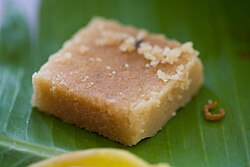Mysore pak
This article needs additional citations for verification. (March 2013) |
 | |
| Course | Dessert |
|---|---|
| Place of origin | India |
| Region or state | Mysore |
| Main ingredients | Ghee, sugar, gram flour |
Mysore pak is a rich sweet dish prepared in Ghee, from Southern India, usually served as dessert. It originated in Mysore. It is made of generous amounts of ghee, sugar, gram flour, and often cardamom.[1] The texture of this sweet is similar to fudge.
History
Mysore pak was first prepared in the kitchens of the Mysore Palace during the regime of Krishna Raja Wadiyar IV, by a palace cook named Kakasura Madappa.[1][2] Madappa made a concoction of gram flour, ghee and sugar. When asked its name, Madappa had nothing in mind, simply called it the 'Mysuru pak'. Pak (or paka, more precisely), in Sanskrit and other Indian vernaculars, means sweet. It is traditionally served in weddings and other festivals of southern India, and is very popular in baby showers as well.
Paaka shastra (short paka) in Kannada means 'cooking procedure' or 'cooking techniques'. Also paka in Kannada refers to sticky sugar syrup obtained by simmering sugar with equal amount of water; specifically for Mysore Pak, the simple syrup is heated to the soft ball stage. The syrup is used as the primary sweetening agent in various Indian sweet dishes like Jalebi, Badam puri, Mysore pak and others. The syrup is flavored with various spice essences like cardamom, rose, honey etc. Paka syrup preparation is a skilled art mastered by few cooks, some of whom keep their methods secret.
References
- ^ a b http://www.thehindu.com/features/metroplus/Food/in-search-of-mysore-pak/article4129960.ece
- ^ Yashaswini S. N. (6 August 2012). "Mysore's own pak, a piece of royalty that melts". The Times of India. Retrieved 23 October 2015.



